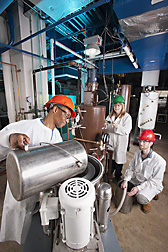Solving Challenges in Sugarcane Factories and Refineries
Award-Winning Factory and Pilot Plant
Studies Provide Solutions
Very high purity. Very low color.
These terms aren’t describing the latest diamonds from Tiffany’s. They describe the ideal qualities of sugar crystals after industrial processing.
In the field, the cane is collected by combine harvesters that chop up, or “billet,” the cane into pieces of about 9 inches in length. Those pieces are shredded at the factory. Juice is then extracted and must be clarified, evaporated, crystallized, and centrifuged, resulting in brownish-yellow crystals called “raw sugar” and molasses. That nonfood-grade raw sugar is then sent to a refinery where it is further melted, clarified, and crystallized into the white sugar found in supermarkets.
The nemesis of these sugar crystals is “trash”—impurities such as leaves and tops and muddy soil that piggyback on sugarcane from the field into the factory. These impurities make processing and clarifying cane juice more difficult.
At the ARS Southern Regional Research Center (SRRC) in New Orleans, Louisiana, chemist Gillian Eggleston has been studying sugarcane that comes into factories containing too much trash. When “trashy” cane enters a factory, processing problems occur that can hurt the bottom line. Eggleston is in the SRRC Commodity Utilization Research Unit.
Traditionally, trash amount has been controlled by burning some sugarcane in the field. But environmental concerns have led to a shift away from burning cane in open fields, and that means more trash on the green cane coming into the factory.
Eggleston has now shed light on the effect of processing green, versus burnt, cane. She traveled to South Africa for 3 months in 2008 and there conducted two large factory and pilot plant studies.
In her studies, she processed burnt whole-stalk cane and burnt and unburnt (trashy) billeted cane to assess the quantity and quality of sugar produced from each of these materials—and the effect of trash on the process.
“We separated the brown and green leaves, growing-point region, or top stalk, and the rest of the stalk and weighed each of these tissues just before they went into the factory,” says Eggleston. “And then we could correlate that data with the results we got.”
Her study showed dramatic effects of harvesting green and burnt billets of cane compared to burnt, whole-stalk cane. “Based on samples produced across the pilot plant that simulated all factory processes, green cane detrimentally affected purity, sugars, ash, and color as well as physical properties such as clarification performance,” says Eggleston. “The data showed us, for the first time, that undesirable color in factory sugar is actually coming from the green leaves in the growing-point region, which occurs at the top part of the stalk.”
|
|
New Approach to Lowering Color
Traditionally, several processes have been used in factories or refineries to lower or remove color—but they are all expensive. Eggleston estimates, from her studies, that for every 1-percent increase in trash levels, there is an increase of about 50 international color units (ICU) for raw sugar and 25 ICU for refinery sugar. She also found that for every 1-percent increase in trash, there is about a one-fifth-percent drop in recoverable crystals. That translates into a $96 million loss per year to the U.S. sugarcane industry.
Her work has led to a recommendation to U.S. sugarcane growers and processors that even a small reduction—such as less than 10 percent—in total trash levels processed at the factory could be more efficient and cost-effective than other factory color-removal processes.
Eggleston won the George and Eleanor Meade Best Paper Award from Sugar Industry Technologists, Inc., (SIT) for her 2009 paper “Factory Trials To Determine How Trash Impacts Downstream Processing,” presented at its annual international meeting. This work was also published in the Proceedings of the South African Sugar Technologists’ Association andwon the association’s 2009 Talbot-Crosbie award for impact on the industry and relevance of the research.
After returning from South Africa, Eggleston spent 2 years building a sugar-processing pilot plant at SRRC. There, a multitude of further experiments can be conducted to study U.S. sugarcane varieties.
Controlling Starch, Controlling Amylase
Another problem associated with the increase in processing green, unburnt cane is increased starch levels in processed raw sugars and products made with those sugars. Use of new U.S. sugarcane varieties is also associated with increases in starch. Now, Eggleston has looked closely at the causes of excess starch in raw and refined sugars, molasses, and food products.
In the United States, an enzyme called “amylase” is added during sugar factory processing to break down long chains of unwanted starch. Eggleston’s research alerted factory processors and refiners to the problem of unwanted carryover amylase activity in molasses and raw sugar if high-temperature commercial amylases were applied in the factory.
“Unless the process of applying factory amylase was improved, starch content in raw sugar would continue to rise,” says Eggleston.
Trials were conducted in three Louisiana-based factories using an amylase that was intermediate-temperature (IT) stable. Eggleston used diluted solutions of amylase to improve contact between the amylase and starch. “When added to factory tanks, the solutions break starch down into smaller, more manageable molecules,” she says.
One of the solutions she tested contained IT-stable amylase diluted threefold in water at the factory. When this solution was added at a dose of 2 parts per million (ppm) per ton of cane juice, starch breakdown was about 32 percent. When the dose was raised to 5 ppm per ton of cane juice, starch breakdown increased to 42 percent. Adding the amylase to the next-to-the-last evaporator—instead of the last evaporator as is traditional—improved starch breakdown even more. Another plus: Using diluted solutions is more cost-effective than using undiluted amylase.
Eggleston won SIT’s Frank Chapman Memorial Award for Best Poster Presentation for her work on optimizing amylase applications in raw sugar manufacture that directly concern refiners. A two-part 2008 paper on the work appears in the International Sugar Journal. Her recommendation that starch buildup can be better controlled or prevented by applying IT-stable amylase is now being followed by several factories in Louisiana.—By Rosalie Marion Bliss, Agricultural Research Service Information Staff.
This research supports the USDA priority of promoting international food security and is part of Quality and Utilization of Agricultural Products, an ARS national program (#306) described at www.nps.ars.usda.gov.
Gillian Eggleston is in the USDA-ARS Commodity Utilization Research Unit, Southern Regional Research Center, 1100 Robert E. Lee Blvd., New Orleans, LA 70179-0687; (504) 286-4446.
"Solving Challenges in Sugarcane Factories and Refineries: Award-Winning Factory and Pilot Plant Studies Provide Solutions" was published in the May/June 2011 issue of Agricultural Research magazine.








